ENGELSK OG AMERIKANSKE STUDIER Linguistics Assignment - Winter 2018
VerifiedAdded on 2022/08/14
|9
|1933
|20
Homework Assignment
AI Summary
This linguistics assignment delves into the core concepts of communication, contrasting human language with animal communication by exploring their similarities and differences. The assignment analyzes the morphological and syntactic structures of language, including derivation, compounding, and reduplication. It also examines the process of language acquisition, focusing on the role of imitation in learning. The student analyzes linguistic data, providing morphological and syntactic breakdowns, and discusses the significance of imitation in language learning, referencing relevant linguistic theories and providing examples to illustrate key concepts. The assignment uses linguistic terminology to explain the distinctions between phones/morphemes and allophones/allomorphs. The assignment concludes by providing a detailed bibliography of sources used.

ENGLISH LANGUAGE AND LINGUISTICS
Name
Course
Date
Name
Course
Date
Paraphrase This Document
Need a fresh take? Get an instant paraphrase of this document with our AI Paraphraser
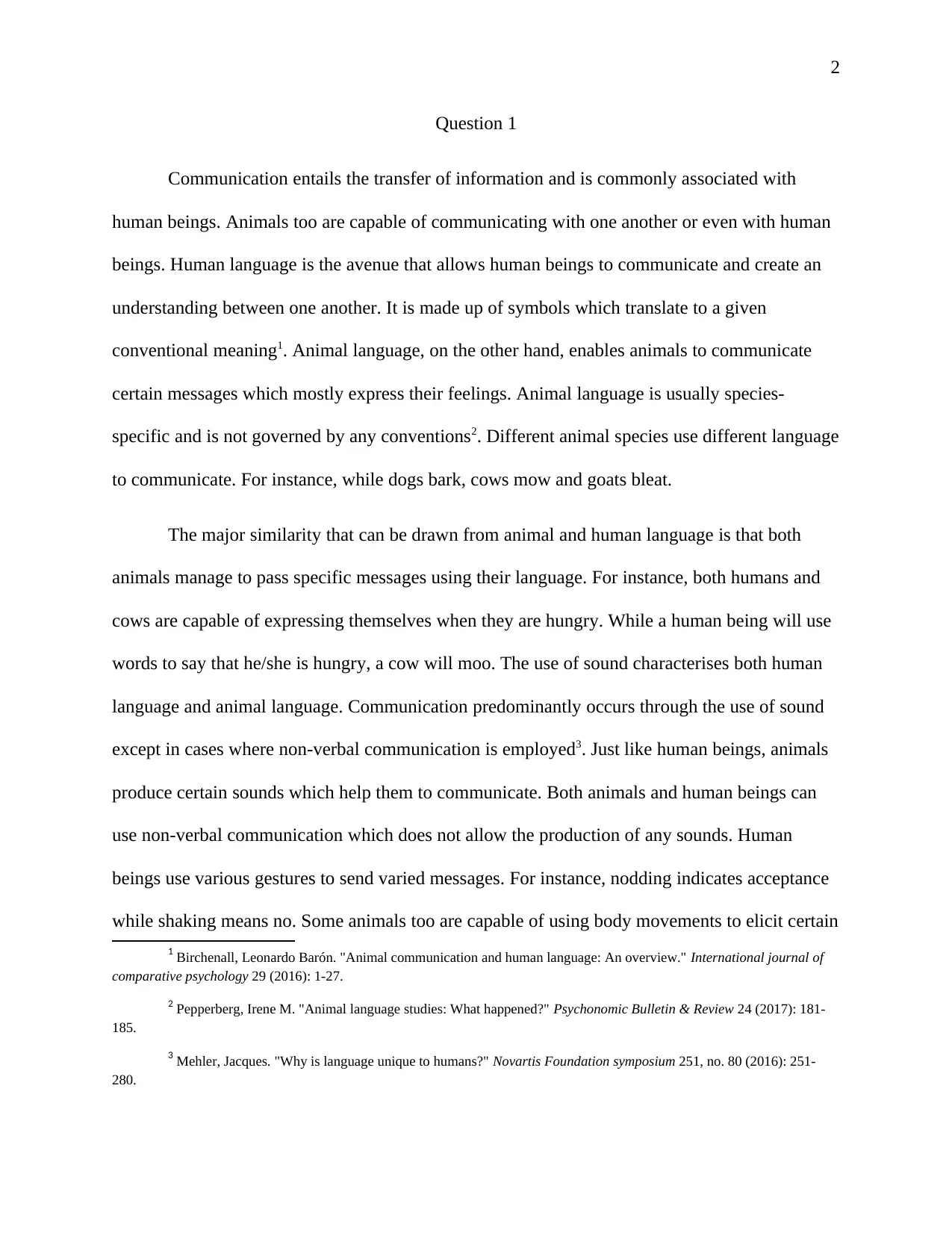
2
Question 1
Communication entails the transfer of information and is commonly associated with
human beings. Animals too are capable of communicating with one another or even with human
beings. Human language is the avenue that allows human beings to communicate and create an
understanding between one another. It is made up of symbols which translate to a given
conventional meaning1. Animal language, on the other hand, enables animals to communicate
certain messages which mostly express their feelings. Animal language is usually species-
specific and is not governed by any conventions2. Different animal species use different language
to communicate. For instance, while dogs bark, cows mow and goats bleat.
The major similarity that can be drawn from animal and human language is that both
animals manage to pass specific messages using their language. For instance, both humans and
cows are capable of expressing themselves when they are hungry. While a human being will use
words to say that he/she is hungry, a cow will moo. The use of sound characterises both human
language and animal language. Communication predominantly occurs through the use of sound
except in cases where non-verbal communication is employed3. Just like human beings, animals
produce certain sounds which help them to communicate. Both animals and human beings can
use non-verbal communication which does not allow the production of any sounds. Human
beings use various gestures to send varied messages. For instance, nodding indicates acceptance
while shaking means no. Some animals too are capable of using body movements to elicit certain
1 Birchenall, Leonardo Barón. "Animal communication and human language: An overview." International journal of
comparative psychology 29 (2016): 1-27.
2 Pepperberg, Irene M. "Animal language studies: What happened?" Psychonomic Bulletin & Review 24 (2017): 181-
185.
3 Mehler, Jacques. "Why is language unique to humans?" Novartis Foundation symposium 251, no. 80 (2016): 251-
280.
Question 1
Communication entails the transfer of information and is commonly associated with
human beings. Animals too are capable of communicating with one another or even with human
beings. Human language is the avenue that allows human beings to communicate and create an
understanding between one another. It is made up of symbols which translate to a given
conventional meaning1. Animal language, on the other hand, enables animals to communicate
certain messages which mostly express their feelings. Animal language is usually species-
specific and is not governed by any conventions2. Different animal species use different language
to communicate. For instance, while dogs bark, cows mow and goats bleat.
The major similarity that can be drawn from animal and human language is that both
animals manage to pass specific messages using their language. For instance, both humans and
cows are capable of expressing themselves when they are hungry. While a human being will use
words to say that he/she is hungry, a cow will moo. The use of sound characterises both human
language and animal language. Communication predominantly occurs through the use of sound
except in cases where non-verbal communication is employed3. Just like human beings, animals
produce certain sounds which help them to communicate. Both animals and human beings can
use non-verbal communication which does not allow the production of any sounds. Human
beings use various gestures to send varied messages. For instance, nodding indicates acceptance
while shaking means no. Some animals too are capable of using body movements to elicit certain
1 Birchenall, Leonardo Barón. "Animal communication and human language: An overview." International journal of
comparative psychology 29 (2016): 1-27.
2 Pepperberg, Irene M. "Animal language studies: What happened?" Psychonomic Bulletin & Review 24 (2017): 181-
185.
3 Mehler, Jacques. "Why is language unique to humans?" Novartis Foundation symposium 251, no. 80 (2016): 251-
280.
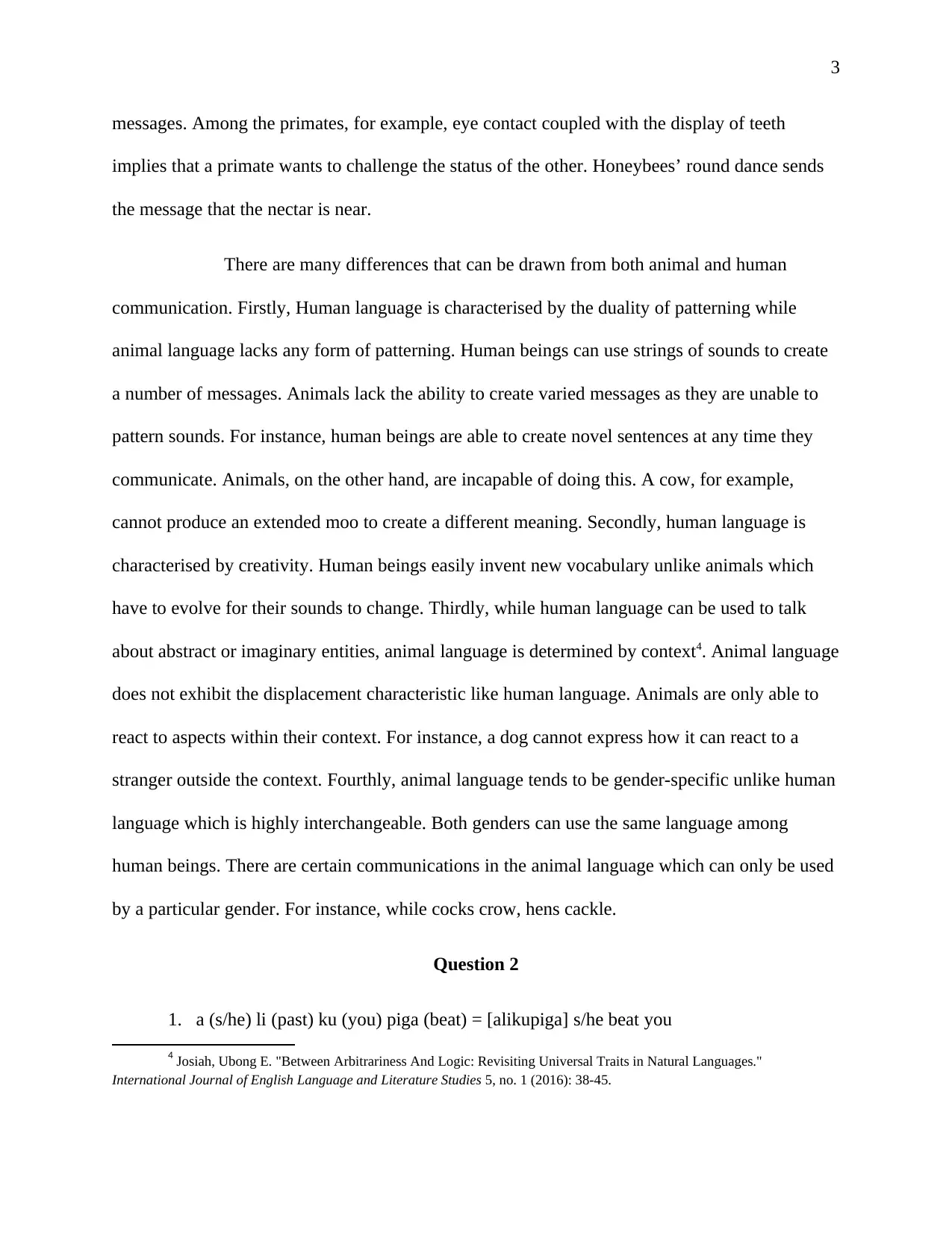
3
messages. Among the primates, for example, eye contact coupled with the display of teeth
implies that a primate wants to challenge the status of the other. Honeybees’ round dance sends
the message that the nectar is near.
There are many differences that can be drawn from both animal and human
communication. Firstly, Human language is characterised by the duality of patterning while
animal language lacks any form of patterning. Human beings can use strings of sounds to create
a number of messages. Animals lack the ability to create varied messages as they are unable to
pattern sounds. For instance, human beings are able to create novel sentences at any time they
communicate. Animals, on the other hand, are incapable of doing this. A cow, for example,
cannot produce an extended moo to create a different meaning. Secondly, human language is
characterised by creativity. Human beings easily invent new vocabulary unlike animals which
have to evolve for their sounds to change. Thirdly, while human language can be used to talk
about abstract or imaginary entities, animal language is determined by context4. Animal language
does not exhibit the displacement characteristic like human language. Animals are only able to
react to aspects within their context. For instance, a dog cannot express how it can react to a
stranger outside the context. Fourthly, animal language tends to be gender-specific unlike human
language which is highly interchangeable. Both genders can use the same language among
human beings. There are certain communications in the animal language which can only be used
by a particular gender. For instance, while cocks crow, hens cackle.
Question 2
1. a (s/he) li (past) ku (you) piga (beat) = [alikupiga] s/he beat you
4 Josiah, Ubong E. "Between Arbitrariness And Logic: Revisiting Universal Traits in Natural Languages."
International Journal of English Language and Literature Studies 5, no. 1 (2016): 38-45.
messages. Among the primates, for example, eye contact coupled with the display of teeth
implies that a primate wants to challenge the status of the other. Honeybees’ round dance sends
the message that the nectar is near.
There are many differences that can be drawn from both animal and human
communication. Firstly, Human language is characterised by the duality of patterning while
animal language lacks any form of patterning. Human beings can use strings of sounds to create
a number of messages. Animals lack the ability to create varied messages as they are unable to
pattern sounds. For instance, human beings are able to create novel sentences at any time they
communicate. Animals, on the other hand, are incapable of doing this. A cow, for example,
cannot produce an extended moo to create a different meaning. Secondly, human language is
characterised by creativity. Human beings easily invent new vocabulary unlike animals which
have to evolve for their sounds to change. Thirdly, while human language can be used to talk
about abstract or imaginary entities, animal language is determined by context4. Animal language
does not exhibit the displacement characteristic like human language. Animals are only able to
react to aspects within their context. For instance, a dog cannot express how it can react to a
stranger outside the context. Fourthly, animal language tends to be gender-specific unlike human
language which is highly interchangeable. Both genders can use the same language among
human beings. There are certain communications in the animal language which can only be used
by a particular gender. For instance, while cocks crow, hens cackle.
Question 2
1. a (s/he) li (past) ku (you) piga (beat) = [alikupiga] s/he beat you
4 Josiah, Ubong E. "Between Arbitrariness And Logic: Revisiting Universal Traits in Natural Languages."
International Journal of English Language and Literature Studies 5, no. 1 (2016): 38-45.
⊘ This is a preview!⊘
Do you want full access?
Subscribe today to unlock all pages.

Trusted by 1+ million students worldwide
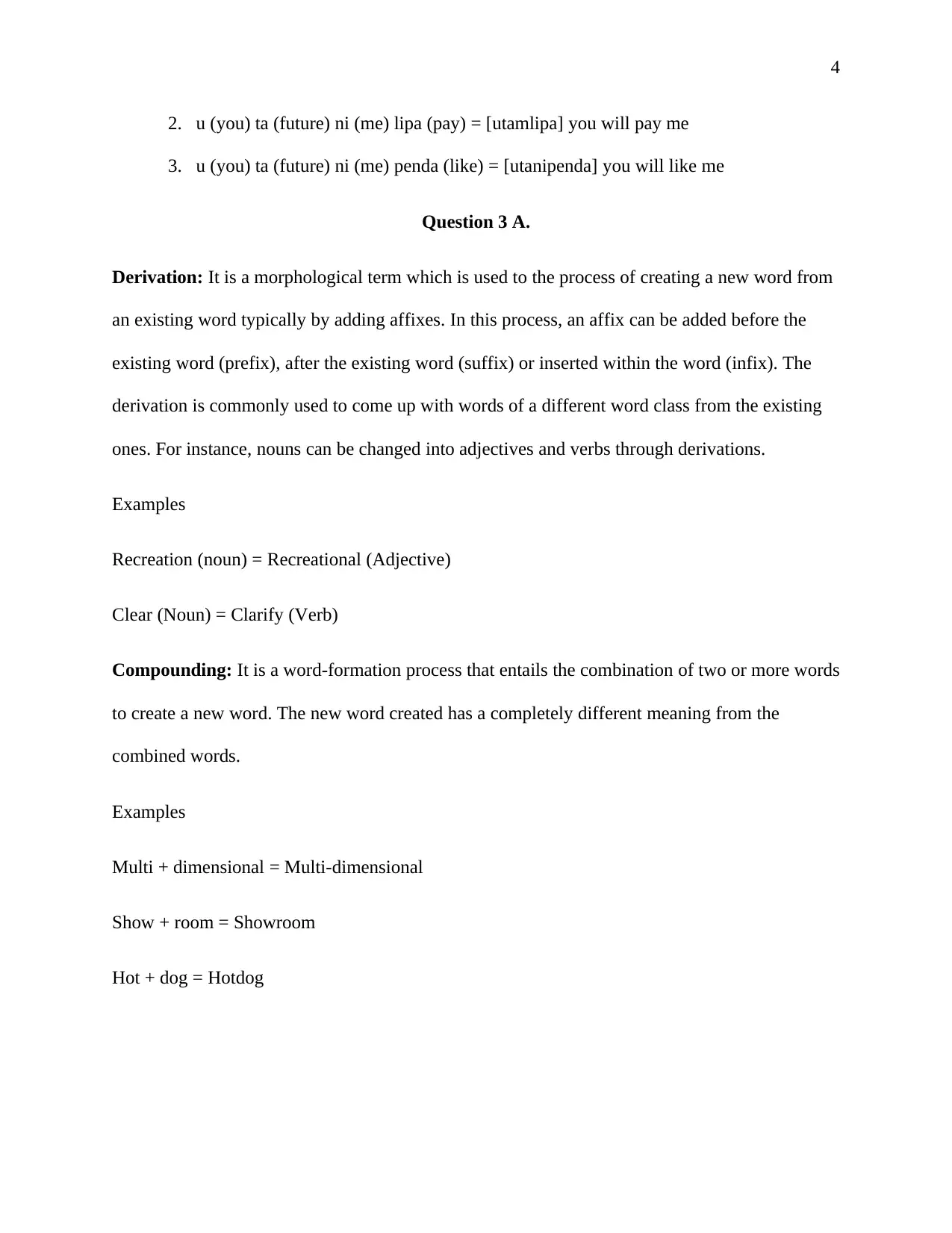
4
2. u (you) ta (future) ni (me) lipa (pay) = [utamlipa] you will pay me
3. u (you) ta (future) ni (me) penda (like) = [utanipenda] you will like me
Question 3 A.
Derivation: It is a morphological term which is used to the process of creating a new word from
an existing word typically by adding affixes. In this process, an affix can be added before the
existing word (prefix), after the existing word (suffix) or inserted within the word (infix). The
derivation is commonly used to come up with words of a different word class from the existing
ones. For instance, nouns can be changed into adjectives and verbs through derivations.
Examples
Recreation (noun) = Recreational (Adjective)
Clear (Noun) = Clarify (Verb)
Compounding: It is a word-formation process that entails the combination of two or more words
to create a new word. The new word created has a completely different meaning from the
combined words.
Examples
Multi + dimensional = Multi-dimensional
Show + room = Showroom
Hot + dog = Hotdog
2. u (you) ta (future) ni (me) lipa (pay) = [utamlipa] you will pay me
3. u (you) ta (future) ni (me) penda (like) = [utanipenda] you will like me
Question 3 A.
Derivation: It is a morphological term which is used to the process of creating a new word from
an existing word typically by adding affixes. In this process, an affix can be added before the
existing word (prefix), after the existing word (suffix) or inserted within the word (infix). The
derivation is commonly used to come up with words of a different word class from the existing
ones. For instance, nouns can be changed into adjectives and verbs through derivations.
Examples
Recreation (noun) = Recreational (Adjective)
Clear (Noun) = Clarify (Verb)
Compounding: It is a word-formation process that entails the combination of two or more words
to create a new word. The new word created has a completely different meaning from the
combined words.
Examples
Multi + dimensional = Multi-dimensional
Show + room = Showroom
Hot + dog = Hotdog
Paraphrase This Document
Need a fresh take? Get an instant paraphrase of this document with our AI Paraphraser
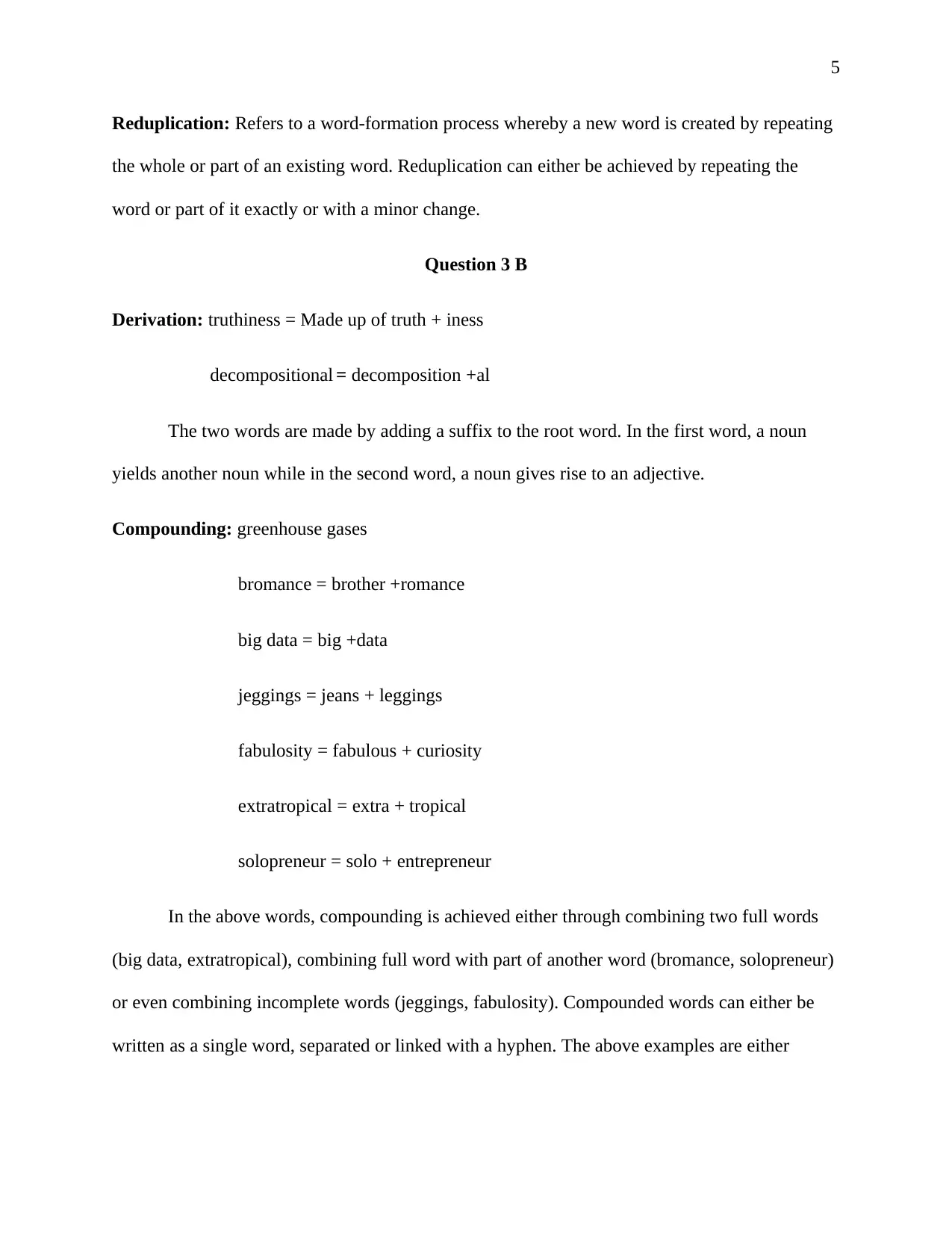
5
Reduplication: Refers to a word-formation process whereby a new word is created by repeating
the whole or part of an existing word. Reduplication can either be achieved by repeating the
word or part of it exactly or with a minor change.
Question 3 B
Derivation: truthiness = Made up of truth + iness
decompositional = decomposition +al
The two words are made by adding a suffix to the root word. In the first word, a noun
yields another noun while in the second word, a noun gives rise to an adjective.
Compounding: greenhouse gases
bromance = brother +romance
big data = big +data
jeggings = jeans + leggings
fabulosity = fabulous + curiosity
extratropical = extra + tropical
solopreneur = solo + entrepreneur
In the above words, compounding is achieved either through combining two full words
(big data, extratropical), combining full word with part of another word (bromance, solopreneur)
or even combining incomplete words (jeggings, fabulosity). Compounded words can either be
written as a single word, separated or linked with a hyphen. The above examples are either
Reduplication: Refers to a word-formation process whereby a new word is created by repeating
the whole or part of an existing word. Reduplication can either be achieved by repeating the
word or part of it exactly or with a minor change.
Question 3 B
Derivation: truthiness = Made up of truth + iness
decompositional = decomposition +al
The two words are made by adding a suffix to the root word. In the first word, a noun
yields another noun while in the second word, a noun gives rise to an adjective.
Compounding: greenhouse gases
bromance = brother +romance
big data = big +data
jeggings = jeans + leggings
fabulosity = fabulous + curiosity
extratropical = extra + tropical
solopreneur = solo + entrepreneur
In the above words, compounding is achieved either through combining two full words
(big data, extratropical), combining full word with part of another word (bromance, solopreneur)
or even combining incomplete words (jeggings, fabulosity). Compounded words can either be
written as a single word, separated or linked with a hyphen. The above examples are either
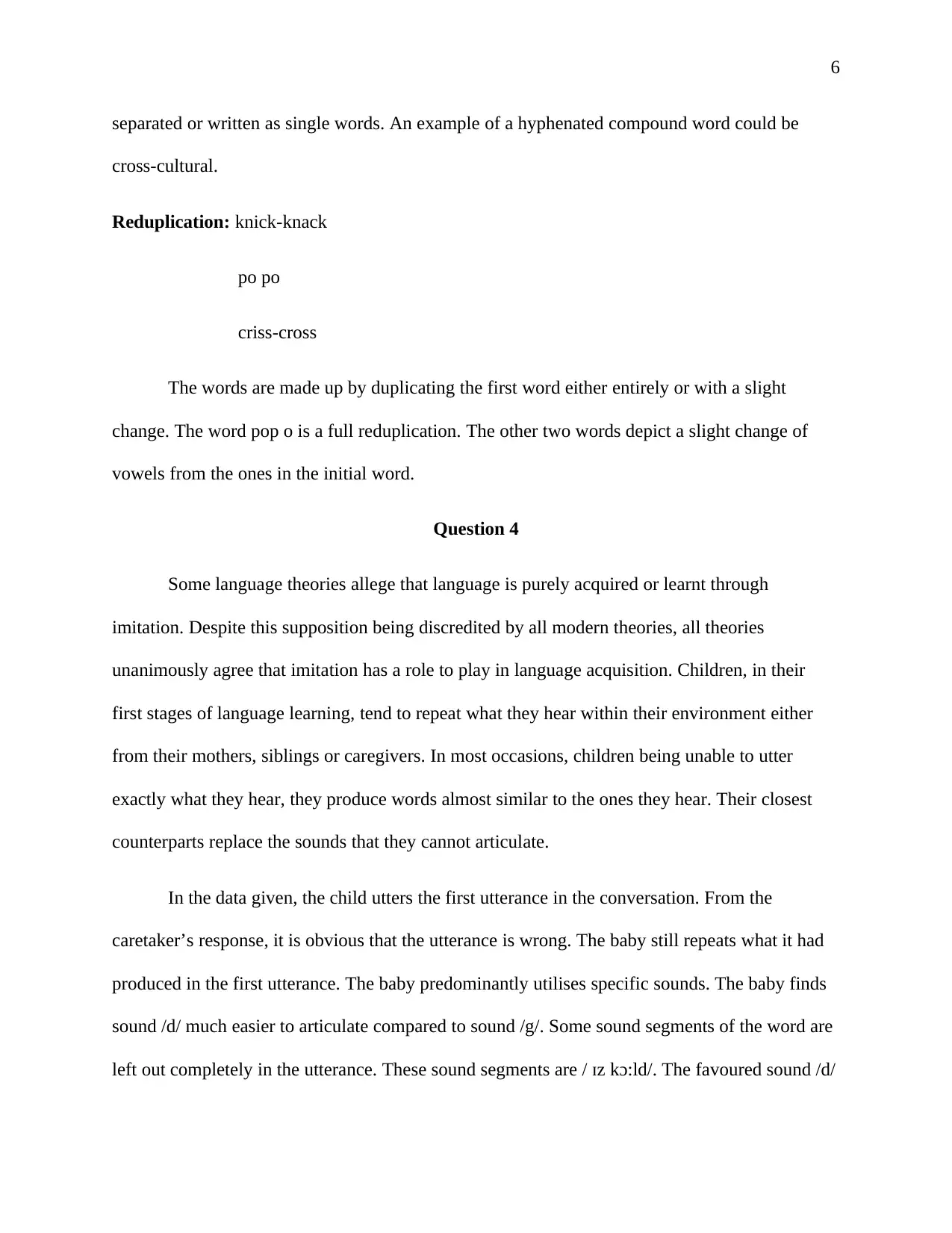
6
separated or written as single words. An example of a hyphenated compound word could be
cross-cultural.
Reduplication: knick-knack
po po
criss-cross
The words are made up by duplicating the first word either entirely or with a slight
change. The word pop o is a full reduplication. The other two words depict a slight change of
vowels from the ones in the initial word.
Question 4
Some language theories allege that language is purely acquired or learnt through
imitation. Despite this supposition being discredited by all modern theories, all theories
unanimously agree that imitation has a role to play in language acquisition. Children, in their
first stages of language learning, tend to repeat what they hear within their environment either
from their mothers, siblings or caregivers. In most occasions, children being unable to utter
exactly what they hear, they produce words almost similar to the ones they hear. Their closest
counterparts replace the sounds that they cannot articulate.
In the data given, the child utters the first utterance in the conversation. From the
caretaker’s response, it is obvious that the utterance is wrong. The baby still repeats what it had
produced in the first utterance. The baby predominantly utilises specific sounds. The baby finds
sound /d/ much easier to articulate compared to sound /g/. Some sound segments of the word are
left out completely in the utterance. These sound segments are / ɪz kɔ:ld/. The favoured sound /d/
separated or written as single words. An example of a hyphenated compound word could be
cross-cultural.
Reduplication: knick-knack
po po
criss-cross
The words are made up by duplicating the first word either entirely or with a slight
change. The word pop o is a full reduplication. The other two words depict a slight change of
vowels from the ones in the initial word.
Question 4
Some language theories allege that language is purely acquired or learnt through
imitation. Despite this supposition being discredited by all modern theories, all theories
unanimously agree that imitation has a role to play in language acquisition. Children, in their
first stages of language learning, tend to repeat what they hear within their environment either
from their mothers, siblings or caregivers. In most occasions, children being unable to utter
exactly what they hear, they produce words almost similar to the ones they hear. Their closest
counterparts replace the sounds that they cannot articulate.
In the data given, the child utters the first utterance in the conversation. From the
caretaker’s response, it is obvious that the utterance is wrong. The baby still repeats what it had
produced in the first utterance. The baby predominantly utilises specific sounds. The baby finds
sound /d/ much easier to articulate compared to sound /g/. Some sound segments of the word are
left out completely in the utterance. These sound segments are / ɪz kɔ:ld/. The favoured sound /d/
⊘ This is a preview!⊘
Do you want full access?
Subscribe today to unlock all pages.

Trusted by 1+ million students worldwide
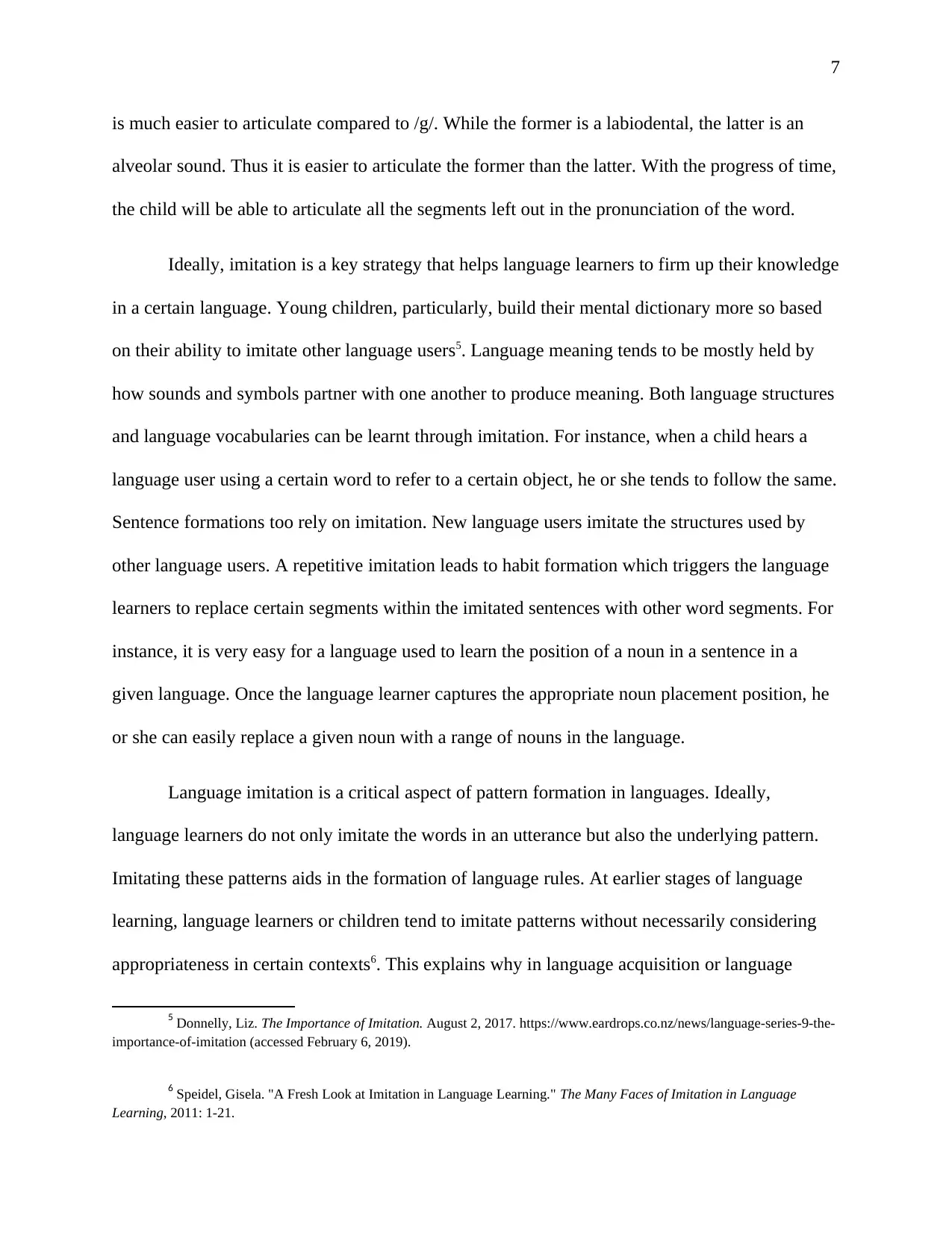
7
is much easier to articulate compared to /g/. While the former is a labiodental, the latter is an
alveolar sound. Thus it is easier to articulate the former than the latter. With the progress of time,
the child will be able to articulate all the segments left out in the pronunciation of the word.
Ideally, imitation is a key strategy that helps language learners to firm up their knowledge
in a certain language. Young children, particularly, build their mental dictionary more so based
on their ability to imitate other language users5. Language meaning tends to be mostly held by
how sounds and symbols partner with one another to produce meaning. Both language structures
and language vocabularies can be learnt through imitation. For instance, when a child hears a
language user using a certain word to refer to a certain object, he or she tends to follow the same.
Sentence formations too rely on imitation. New language users imitate the structures used by
other language users. A repetitive imitation leads to habit formation which triggers the language
learners to replace certain segments within the imitated sentences with other word segments. For
instance, it is very easy for a language used to learn the position of a noun in a sentence in a
given language. Once the language learner captures the appropriate noun placement position, he
or she can easily replace a given noun with a range of nouns in the language.
Language imitation is a critical aspect of pattern formation in languages. Ideally,
language learners do not only imitate the words in an utterance but also the underlying pattern.
Imitating these patterns aids in the formation of language rules. At earlier stages of language
learning, language learners or children tend to imitate patterns without necessarily considering
appropriateness in certain contexts6. This explains why in language acquisition or language
5 Donnelly, Liz. The Importance of Imitation. August 2, 2017. https://www.eardrops.co.nz/news/language-series-9-the-
importance-of-imitation (accessed February 6, 2019).
6 Speidel, Gisela. "A Fresh Look at Imitation in Language Learning." The Many Faces of Imitation in Language
Learning, 2011: 1-21.
is much easier to articulate compared to /g/. While the former is a labiodental, the latter is an
alveolar sound. Thus it is easier to articulate the former than the latter. With the progress of time,
the child will be able to articulate all the segments left out in the pronunciation of the word.
Ideally, imitation is a key strategy that helps language learners to firm up their knowledge
in a certain language. Young children, particularly, build their mental dictionary more so based
on their ability to imitate other language users5. Language meaning tends to be mostly held by
how sounds and symbols partner with one another to produce meaning. Both language structures
and language vocabularies can be learnt through imitation. For instance, when a child hears a
language user using a certain word to refer to a certain object, he or she tends to follow the same.
Sentence formations too rely on imitation. New language users imitate the structures used by
other language users. A repetitive imitation leads to habit formation which triggers the language
learners to replace certain segments within the imitated sentences with other word segments. For
instance, it is very easy for a language used to learn the position of a noun in a sentence in a
given language. Once the language learner captures the appropriate noun placement position, he
or she can easily replace a given noun with a range of nouns in the language.
Language imitation is a critical aspect of pattern formation in languages. Ideally,
language learners do not only imitate the words in an utterance but also the underlying pattern.
Imitating these patterns aids in the formation of language rules. At earlier stages of language
learning, language learners or children tend to imitate patterns without necessarily considering
appropriateness in certain contexts6. This explains why in language acquisition or language
5 Donnelly, Liz. The Importance of Imitation. August 2, 2017. https://www.eardrops.co.nz/news/language-series-9-the-
importance-of-imitation (accessed February 6, 2019).
6 Speidel, Gisela. "A Fresh Look at Imitation in Language Learning." The Many Faces of Imitation in Language
Learning, 2011: 1-21.
Paraphrase This Document
Need a fresh take? Get an instant paraphrase of this document with our AI Paraphraser
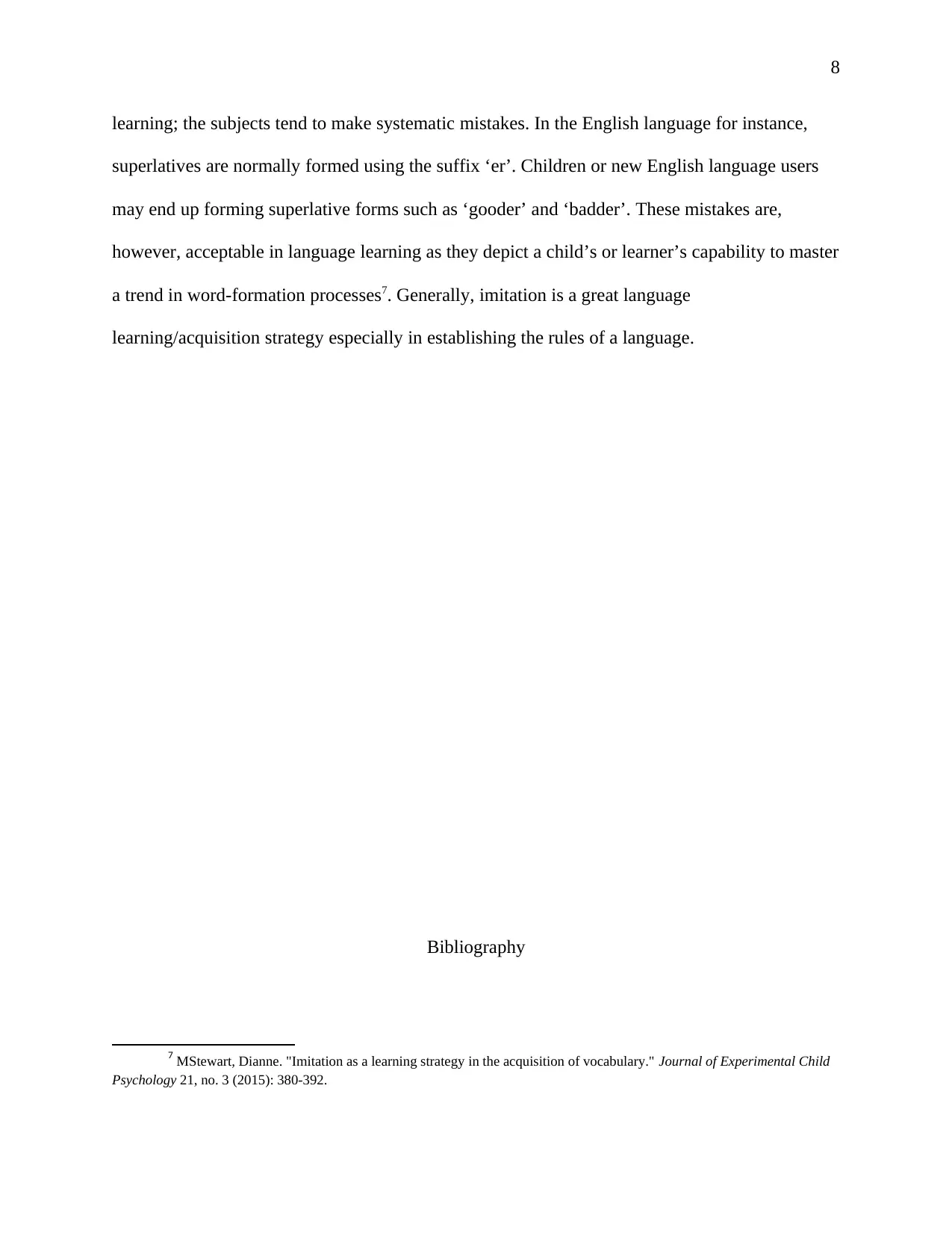
8
learning; the subjects tend to make systematic mistakes. In the English language for instance,
superlatives are normally formed using the suffix ‘er’. Children or new English language users
may end up forming superlative forms such as ‘gooder’ and ‘badder’. These mistakes are,
however, acceptable in language learning as they depict a child’s or learner’s capability to master
a trend in word-formation processes7. Generally, imitation is a great language
learning/acquisition strategy especially in establishing the rules of a language.
Bibliography
7 MStewart, Dianne. "Imitation as a learning strategy in the acquisition of vocabulary." Journal of Experimental Child
Psychology 21, no. 3 (2015): 380-392.
learning; the subjects tend to make systematic mistakes. In the English language for instance,
superlatives are normally formed using the suffix ‘er’. Children or new English language users
may end up forming superlative forms such as ‘gooder’ and ‘badder’. These mistakes are,
however, acceptable in language learning as they depict a child’s or learner’s capability to master
a trend in word-formation processes7. Generally, imitation is a great language
learning/acquisition strategy especially in establishing the rules of a language.
Bibliography
7 MStewart, Dianne. "Imitation as a learning strategy in the acquisition of vocabulary." Journal of Experimental Child
Psychology 21, no. 3 (2015): 380-392.
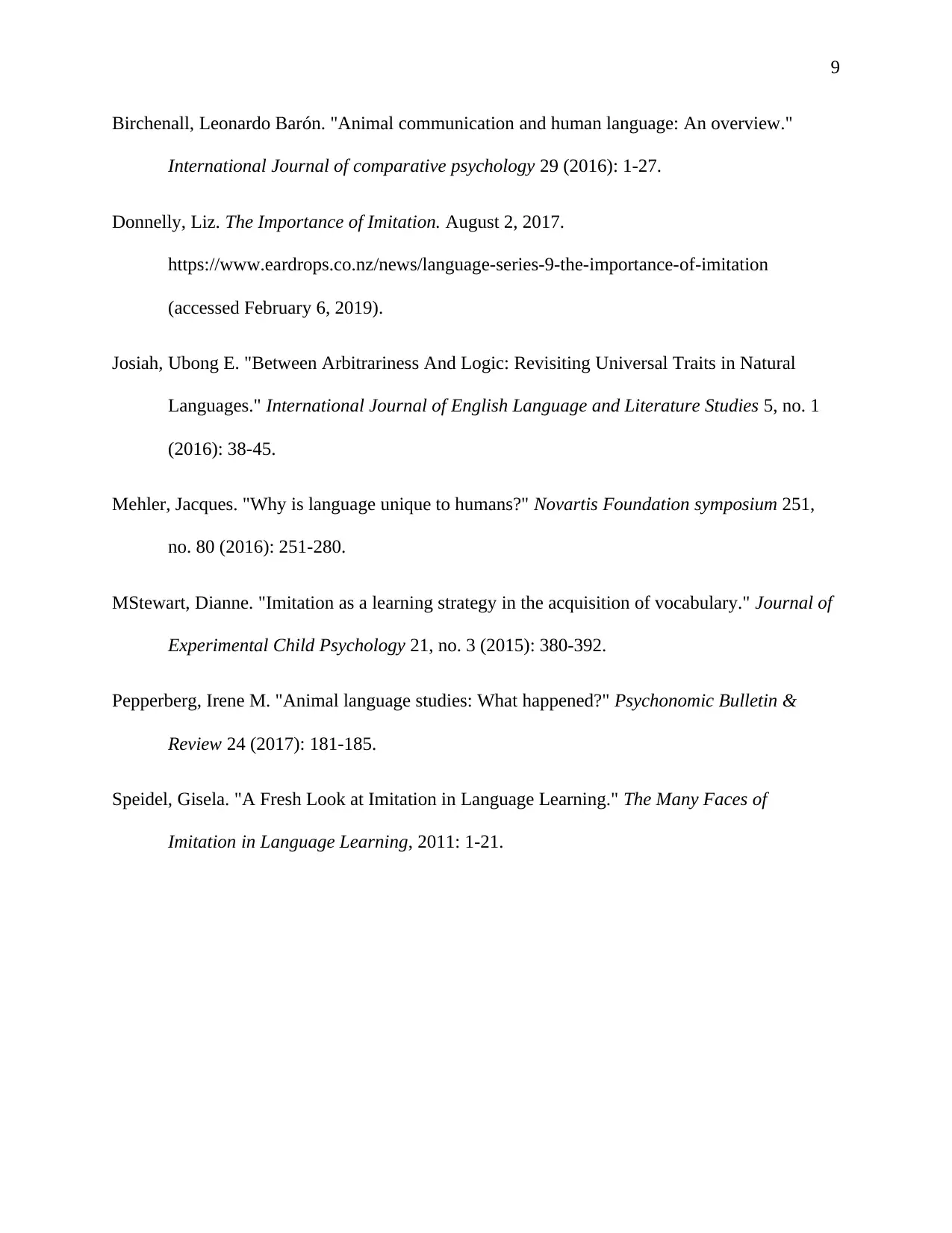
9
Birchenall, Leonardo Barón. "Animal communication and human language: An overview."
International Journal of comparative psychology 29 (2016): 1-27.
Donnelly, Liz. The Importance of Imitation. August 2, 2017.
https://www.eardrops.co.nz/news/language-series-9-the-importance-of-imitation
(accessed February 6, 2019).
Josiah, Ubong E. "Between Arbitrariness And Logic: Revisiting Universal Traits in Natural
Languages." International Journal of English Language and Literature Studies 5, no. 1
(2016): 38-45.
Mehler, Jacques. "Why is language unique to humans?" Novartis Foundation symposium 251,
no. 80 (2016): 251-280.
MStewart, Dianne. "Imitation as a learning strategy in the acquisition of vocabulary." Journal of
Experimental Child Psychology 21, no. 3 (2015): 380-392.
Pepperberg, Irene M. "Animal language studies: What happened?" Psychonomic Bulletin &
Review 24 (2017): 181-185.
Speidel, Gisela. "A Fresh Look at Imitation in Language Learning." The Many Faces of
Imitation in Language Learning, 2011: 1-21.
Birchenall, Leonardo Barón. "Animal communication and human language: An overview."
International Journal of comparative psychology 29 (2016): 1-27.
Donnelly, Liz. The Importance of Imitation. August 2, 2017.
https://www.eardrops.co.nz/news/language-series-9-the-importance-of-imitation
(accessed February 6, 2019).
Josiah, Ubong E. "Between Arbitrariness And Logic: Revisiting Universal Traits in Natural
Languages." International Journal of English Language and Literature Studies 5, no. 1
(2016): 38-45.
Mehler, Jacques. "Why is language unique to humans?" Novartis Foundation symposium 251,
no. 80 (2016): 251-280.
MStewart, Dianne. "Imitation as a learning strategy in the acquisition of vocabulary." Journal of
Experimental Child Psychology 21, no. 3 (2015): 380-392.
Pepperberg, Irene M. "Animal language studies: What happened?" Psychonomic Bulletin &
Review 24 (2017): 181-185.
Speidel, Gisela. "A Fresh Look at Imitation in Language Learning." The Many Faces of
Imitation in Language Learning, 2011: 1-21.
⊘ This is a preview!⊘
Do you want full access?
Subscribe today to unlock all pages.

Trusted by 1+ million students worldwide
1 out of 9
Your All-in-One AI-Powered Toolkit for Academic Success.
+13062052269
info@desklib.com
Available 24*7 on WhatsApp / Email
![[object Object]](/_next/static/media/star-bottom.7253800d.svg)
Unlock your academic potential
Copyright © 2020–2025 A2Z Services. All Rights Reserved. Developed and managed by ZUCOL.


